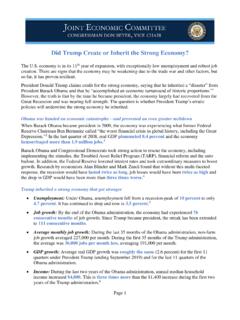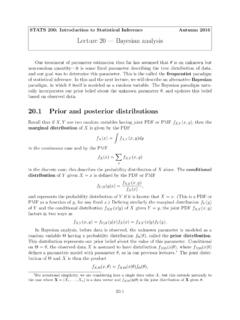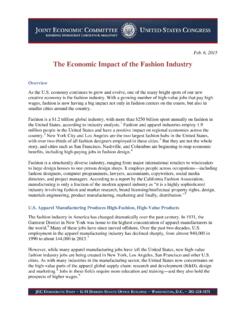Transcription of The Economic State of Black America in 2020
1 The Economic State of Black America in 2020. Over the past half-century, Black Americans have made substantial social and Economic progress, gaining political rights that long had been denied to them, entering professions from which they had been blocked and largely overcoming centuries of overt racism and oppression. While there were only five Black Members of Congress when the Civil Rights Act became law in 1964, there currently are 56 Black Members of Congress, including 12% of the House of Representatives. Black activists, scholars, and social commentators have raised awareness about the importance of diversity and shaped the national conversation around race and inequality. There has been a proliferation of Black writers, screenwriters, artists, poets, athletes and musicians who have become superstars in their respective fields.
2 And the 21st century saw the election of the first Black American, Barack Obama, as president of the United States. Millions of Black Americans also have benefited from the opportunities created by the de jure end of Jim Crow, entering the middle class for the first time, earning undergraduate and advanced degrees, receiving higher wages, achieving professional success and raising children who will build on their achievements. Leading indicators of Economic prosperity and other measures of well-being also have trended upward for most of this period, with increased life expectancy, increased household incomes and substantial gains in educational attainment. However, these very visible signs of improvement mask deep inequities that relegate tens of millions of Black Americans to second-class status, with far fewer opportunities to achieve good health, political influence, prosperity and security than other Americans.
3 The majority of Americans fail to recognize the magnitude of these problems. For example, a 2019 study found that over 97% of respondents vastly underestimated the huge gap between the median wealth held by Black families ($17,000) and White families ($171,000) a ratio of 10 to one. Respondents estimated the gap to be 80 percentage points smaller than the actual divide. The data reveal a much different story, with leading indicators of social and Economic well-being showing that, on average, Black Americans face much more difficult circumstances than their White counterparts. For example, Black Americans take home less income, are far less likely to own their homes and live shorter lives than White Americans. Evaluating the Economic State of Black America requires acknowledging that while the United States has made some progress, very large disparities continue to exist.
4 Recognizing both the progress and the challenges is essential to ensuring that all Americans, including Black Americans, have a realistic chance to achieve success. The Economic State of Black America in 2020. KEY POINTS. Despite significant Economic progress over the past decades, Black Americans experience far worse Economic conditions than Whites or the population as a whole. Historically, the unemployment rate for Black Americans has been approximately twice the rate for Whites. That is the case today for Black workers and for Whites. The difference in the unemployment rates for Blacks and Whites shrinks for college graduates; however, even in the current strong economy the unemployment rate is 50% higher for Black Americans. During the majority of the past 50 years, Black Americans have experienced unemployment rates that, were they experienced by the entire population, would be seen as recessionary.
5 Black workers have been disproportionally hurt by the overall decline in union membership and the decreasing power of unions. The typical Black households earns a fraction of White households just 59 cents for every dollar. The gap between Black and White annual household incomes is about $29,000 per year. Black Americans are over twice as likely to live in poverty as White Americans. Black children are three times as likely to live in poverty as White children. The median wealth of Black families ($17,000) is less than one-tenth that of White families ($171,000). The wealth gap between Black and White households increases with education. Much less than half (42%) of Black families own their homes, compared to almost three-quarters (73%) of White families. High school graduation rates for Black and White Americans have nearly converged.
6 The share of Blacks who are college graduates has more than doubled since 1990, from 11% to 25% but still lags far behind Whites. Persistent segregation leads to large disparities in the quality of secondary education, leading to worse Economic outcomes. The incarceration rate for Black Americans is falling, but is still nearly six times the rate for White Americans. Non-Hispanic Black Americans have a life expectancy years lower than non- Hispanic White Americans. Page 2. The Economic State of Black America in 2020. TABLE OF CONTENTS. EMPLOYMENT .. 5. The unemployment rate for Black Americans is much higher than for Whites .. 5. Racial disparities in unemployment rates exist at every education 5. A smaller share of Black Americans are in the labor force .. 6. Discrimination and occupational segregation are significant causes of racial disparities.
7 6. UNIONIZATION .. 7. Black workers are more likely to be members of labor unions .. 7. Union membership reduces wage differentials between Blacks and Whites .. 7. Falling union membership rates are particularly harmful to Black workers .. 7. WAGES AND INCOME .. 8. Black households earn a fraction of what White households earn .. 8. Black workers are more likely to earn the minimum wage .. 9. College-educated Black workers fare worse in comparison to White workers .. 10. Black women are doubly 10. POVERTY AND Economic 11. Black Americans are over twice as likely to live in poverty as White Americans .. 11. High poverty rates among Black Americans have lifelong consequences .. 12. Black Americans experience far less upward Economic mobility .. 12. Black Americans depend more on the social safety net.
8 12. WEALTH .. 12. The median wealth of Black families is only one-tenth that of White families .. 12. A college education does not decrease the wealth gap .. 13. Historical disparities perpetuate the Black -White wealth gap .. 13. Many Black college graduates have difficulty paying off student loan debt .. 14. Black Americans approaching retirement have far less savings .. 14. HOMEOWNERSHIP .. 14. Black Americans are far less likely to own their own homes than White Americans .. 14. Homes in majority- Black neighborhoods are valued lower .. 15. Black Americans overall pay higher mortgage interest rates .. 15. Page 3. The Economic State of Black America in 2020. Black homeownership rates are trending downward .. 15. EDUCATION .. 16. High school graduation and dropout shares for Blacks and Whites have nearly converged.
9 16. The share of Black college graduates has doubled but still lags far behind whites .. 17. Racial segregation leads to large educational disparities .. 17. concentrated poverty leads to weak student performance .. 18. A lack of teacher diversity worsens outcomes .. 18. Nonwhite school districts as a whole are more poorly funded .. 18. INCARCERATION .. 19. One in three Black men will be incarcerated over his lifetime .. 19. The incarceration rate for Black Americans is falling, but is nearly six times the rate for White Americans .. 20. VOTING RIGHTS .. 21. Black voter turnout decreased in 21. Decreased voter turnout is partly a result of voter suppression .. 21. 22. Black Americans have a significantly lower life expectancy than Whites .. 22. Blacks have a lower life expectancy despite White deaths of despair.
10 23. Black Americans suffer far higher rates of infant and pregnancy-related mortality .. 23. Discrimination may contribute to worse health outcomes .. 24. Health insurance rates for Blacks rose under Obama, then have fallen under Trump .. 25. CONCLUSION .. 27. State 28. ENDNOTES .. 29. Page 4. The Economic State of Black America in 2020. EMPLOYMENT. The unemployment rate for Black Americans is much higher than for Whites The economy provides Black Americans with far fewer opportunities for stable, well- paying employment than their White counterparts. Over the past 50 years, the unemployment rate for Blacks consistently has been approximately twice that of Whites. Although President Trump in his recent State of the Union Address heralded the fact the Black unemployment rate had dropped to 6% in January 2020, it still is almost twice the White unemployment rate of The spread between White and Black unemployment increases when overall unemployment rises and decreases when it falls.

















